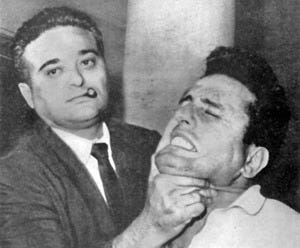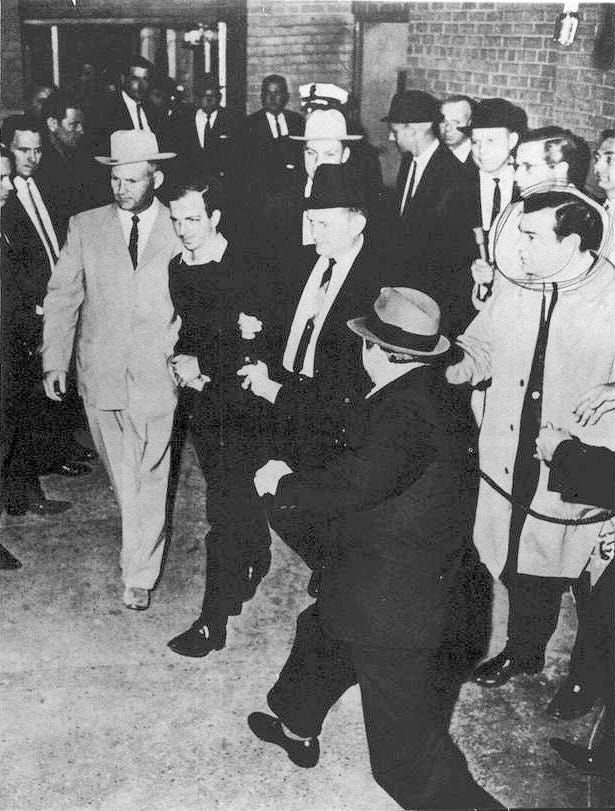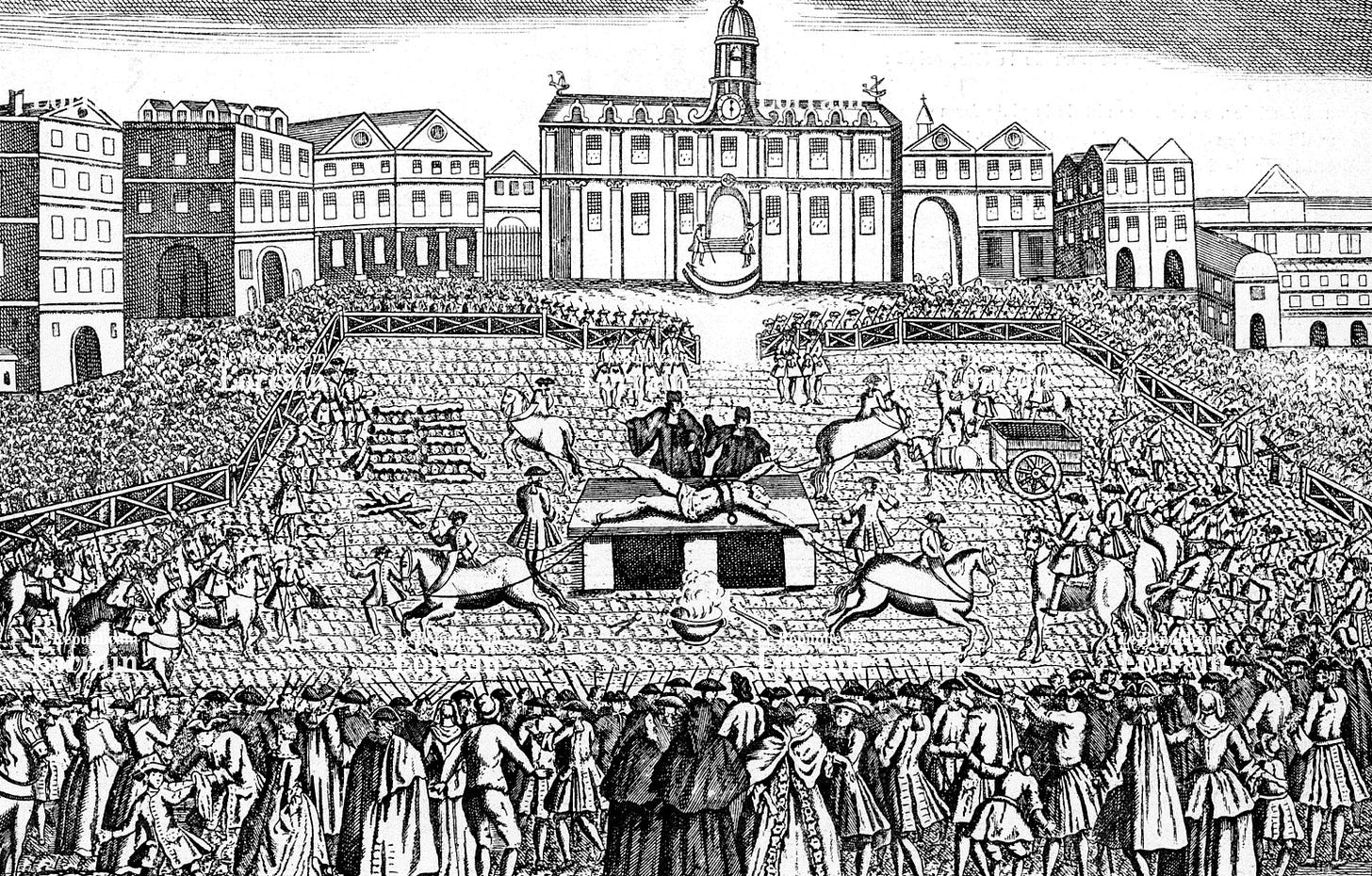Santa Claus and Other Lies
Nobody told me that wrestling was fake. Bound to the convex glass of the TV screen, I winced at the aerial jabs and drop kicks, recoiled as foldable chairs embraced the burly backs of brutal wrestlers. My cousins sat next to me, similarly transfixed, enrobed by the humid Boca Raton air. Did they know?
What the public wants is the image of passion, not passion itself. (Barthes)
Black is Turning Blue
On March 28, 1757, I stood, bundled in cheap wools, on the Place de Greve in the 4th Arrondissement. The door of the Hotel de Ville slowly opened, its heavy hinges humming as soldiers pulled on the massive brass handles. Surrounded by an army strong enough to take Paris, Robert-François Damiens appeared, his face haggard, prison-clothes tattered, horses towering over him. For attempted regicide, Robert was quartered for hours in front of a cheering crowd. The public execution is a ritual of Royal strength and societal catharsis. Murderers and traitors are walked onto the gallows where the State’s sharp might slices their heads off. On some days, it ties nooses or orders four horses to go as fast as they can. The execution is humiliation and necropolitics. It is the State’s reminder of its sovereign ability to unilaterally confer death upon the living.
The tortured body is first inscribed in the legal ceremonial that must produce, open for all to see, the truth of the crime. (Foucault)
The Emperor’s Thumb
Necropolitics is a concept developed by political theorist Achille Mbembe, referring to the exercise of power by sovereign authorities to determine who lives and who dies. It describes how political power is enacted through the subjugation of life to death, focusing on the ways in which states or other entities create conditions where certain groups or individuals are subjected to violence, exclusion, or symbolic and literal death.
The perp walk is such an example of symbolic death. It is highly notable that the perp walk occurs before any verdict is rendered, when the perp is still, according to our system, presumed innocent. Thus, the symbolic punishment is made salient before the crime, as a tool of dissuasion to other would-be criminals, but also as a tool of myth-making to the public.
The function of the wrestler is not to win; it is to go exactly through the motions which are expected of him. (Barthes)
Duh!
Wrestling is a choreographed performance that enacts the known myths of the Western world. Like in the Commedia dell’arte, there are archetypal characters whose storied journeys we know and love to observe. “In professional wrestling, bad guys are called heels, and they are antagonists to the good guys, or faces. Heels are meant to get the crowd to hate them, and they often use underhanded tactics like cheating or using foreign objects.” American wrestling, Barthes observes, hinges on the dichotomy of Good versus Bad, where 'Good' invariably wins.
In 1903, before the term was even coined, NYPD inspector George W. McClusky arrested important members of the Morello crime family, a powerful Mafia group at the time. After a night in a cell, McClusky made the handcuffed suspects walk through Little Italy, in front of their peers and fellow Italian immigrants. Historian Thomas Repetto writes that the parades of mafiosi were taken from the Italian police who orchestrated similar spectacles to “dramatize the powerlessness [of the criminals].” (Repetto 2005)

The gesture of the vanquished wrestler signifying to the world a defeat which, far from disguising, he emphasizes and holds like a pause in music, corresponds to the mask of antiquity meant to signify the tragic mode of the spectacle. (Barthes)
It’s me, Ruby?
November 24, 1963. I taped all of Lee’s appearances on television. The 24-year old was paraded often in front of cameras to answer questions. Young guy, thin guy. Eyes sloping downwards like a troubled fox. I re-watched the interviews and paused to study the facial reactions and tics that bubbled onto his hollow face. The regicide. Heir to Damiens. 11:21 am. As Lee answered questions, flanked by tall police officers in dark suits and uniforms, a figure obscured the camera. Jack pulled out a .38 caliber Colt Cobra revolver and shot the perp. The ceremony, the ritual is violently ruptured by the chaos of uncontrolled death. An untimely final act. The real’s revenge?
The grandiloquent truth of gestures on life’s great occasions. (Baudelaire)

No, Rudy!
Perp walks were made popular again in the 1980s by then Attorney General Rudy Giuliani, who, at the time, was running on a “tough on crime” agenda. Giuliani understood that spectacle was crucial in heightening the visibility of the agenda’s success. Giuliani’s perp walks represented a throwback to the earlier era of public punishment, where power was displayed through the body of the condemned. According to criminal law professor Laurie Levenson, “Rudy Giuliani made an art form out of [perp walks].” He paraded “corrupt bankers, drug dealers, mob members”, all in an effort to elevate the public standing of prosecutors and to remind all that no one is above the State, no one is above the Law.
The performance of safety is as important as safety itself.
Perp walks were always an art form, always a form of theater.
Why did you feel the need to go to the heliport and greet him?
I was at a conference a few days ago with top CEOs. The shooting really traumatized the entire industry. I wanted to send a strong message with the police commissioner that we are leading from the front. I wanted to be there to show the symbolism of that. (Mayor Adams, 2024)
The Hero with A Million Faces?
Myths work in monocultures. Myths work when a shared understanding exists, when we all converge on a singular scapegoat. The heel, the loathsome mafioso, the morally bankrupt white collar criminal, the murderer were, in most cases, palatable objects of ill will. As scapegoats, their image effectuated the required societal catharsis, expunging the angst held tightly with the collective psyche. Luigi’s perp walk exemplifies the contention with myth-making in a pluriculture. Where there once was a convergence, there is now a dislocation. The image of the perp walk was once monolithic, serving the State, the prosecution, demonstrating its power and righteousness. The meaning has now splintered, it has become polysemic. Now, many myths emerge.
You’re applauding for Justice, right? (Colin Jost responding to the crowd cheering, after he mentioned Luigi on SNL, December 21st, 2024)
Pseudo-mythologies
A pseudo-event, a term popularized by Boorstin in his book “The Image: A Guide to Pseudo-Events in America”, is an event produced by a communicator with the sole purpose of generating media attention and publicity. Whereas propaganda slants facts to keep the public from learning the truth, pseudo-events provide the public with artificial facts that people perceive as real.
The perp walk is a quintessential pseudo-event. It exists for the purpose of being mediatized. It is organized so that the media can capture the spectacle of power. Why the grand parade? Why the unnecessary ceremony? Why does it look like a Marvel movie? Because it is. It’s capes and villains, heroes and thieves, faces and heels, good guys and bad guys. It is fiction inasmuch as it is factitious. The events are “real” but their significance is created through the pageantry of spectacle. There is a myth at play here: read it as you want.
Every perp walk is a repetitive sequel to the original myth.
Icons are sites of projection and, in large part, sites of fantasy. [...] It is a quasi-spiritualism that transforms figures, flawed in their everyday humanity, into simultaneous saints and martyrs. (Russell)
Chapter 3
An image is synthetic.
An image is believable.
An image is passive.
An image is vivid and concrete.
An image is simplified.
An image is ambiguous.
The image lets us believe for an instant that we are not alone.
Necromemetics
Our society does not shy away from the wretched barbarity of necropolitics. It has however developed more subtle ways to confer death, symbolically.
Necromemetics is the process by which symbolic death is enacted on individuals or groups through the repetitive circulation of digital images, memes, or videos. These images, through their widespread reproduction and reinterpretation, strip the subject of agency, dignity, or humanity, reducing them to objects of ridicule, adoration, moral condemnation or martyrdom in the digital sphere. The perp walk and its mediatization is an early form of necromemetics. Good or bad, the groups and individuals become mere icons, symbolically dead and frozen for our incessant consumption.
Necromemetics is the effectuation of sovereign and collective power in the realm of the digital. It turns bodies into pure symbols, pure signs, icons. Under symbolic death, the icon becomes ripe for remix, memefication and partisan exegesis. In the words of Legacy Russell, they become a “site[s] of projection” and “fantasy.”
Fantasy is a negative version of a religious myth. (Jackson)
Amende Honorable
Necromemetics is the main output of culture wars. Symbolic death feels like power in the tiny fingers of the fast-typing belligerent egregores.
But.
When the needle pricks and pierces the epidermis, when the poison is pushed patiently through the perpetrator’s veins, when the body rigidifies itself under the weight of death slowly coming on, there is no more “image”, no more “myth”, and that is the true expression of power.
Do they know?
Under the conditions of necropower, the lines between resistance and suicide, sacrifice and redemption, martyrdom and freedom are blurred. (Mbembe)






